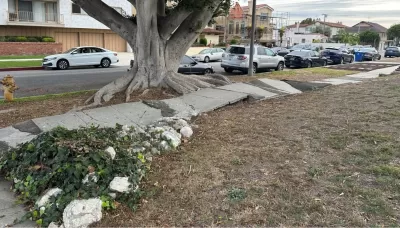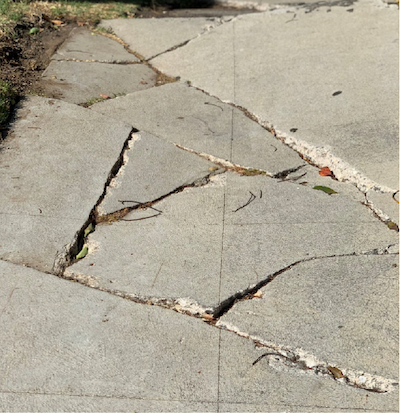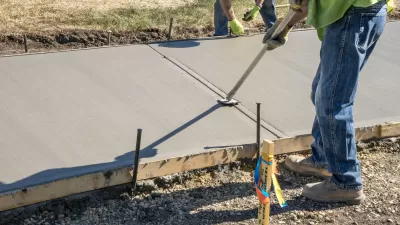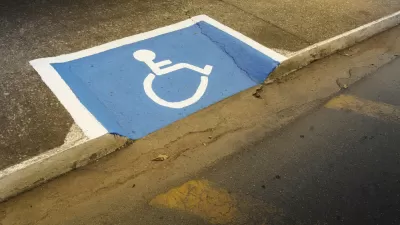Can Los Angeles fix 4,000 miles of broken sidewalks before the city hosts the 2028 Olympic Games?

The Americans with Disabilities Act (ADA) requires cities to keep their sidewalks accessible for people with disabilities. In 2016, to settle an ADA lawsuit, Los Angeles committed to spending $1.4 billion over 30 years to repair its nearly 4,000 miles of broken, inaccessible sidewalks.
 A 2021 audit by the Los Angeles Controller’s Office revealed that, since 2016, the city had repaired less than 1 percent of its sidewalks. During that period, the city paid $35 million in lawsuit settlements related to sidewalk injuries. At the current rate, the Controller warned, it will take 500 years to fix all the broken sidewalks in Los Angeles.
A 2021 audit by the Los Angeles Controller’s Office revealed that, since 2016, the city had repaired less than 1 percent of its sidewalks. During that period, the city paid $35 million in lawsuit settlements related to sidewalk injuries. At the current rate, the Controller warned, it will take 500 years to fix all the broken sidewalks in Los Angeles.
The Olympic and Paralympic Games have created a strong incentive for Los Angeles to fix its broken sidewalks before 2028. The promised car-free Olympics will require a lot of walking, and it will be humiliating for Los Angeles if sidewalks near Olympic venues remain inaccessible for people with disabilities.
The Olympic and Paralympic Villages on the UCLA campus (which is fully accessible) will be across the street from North Westwood Village, a neighborhood filled with broken sidewalks. Failure to repair these inaccessible sidewalks before the Games will give Los Angeles a catastrophic black eye on the world stage.
Good and bad news
How can Los Angeles pay to fix all its broken sidewalks before 2028? The answer is simple: The city doesn’t need to pay anything. Both California and Los Angeles codes require property owners to pay for sidewalk repairs. Los Angeles city code states: “The owner of a Lot shall maintain any Sidewalk fronting on the Lot in such condition that the Sidewalk will not violate the Americans with Disabilities Act.”
The downside? Los Angeles has not enforced this law because it is unpopular with homeowners. The average cost of fixing a broken sidewalk in Los Angeles is about $12,000 per property, and homeowners who live paycheck to paycheck don’t have the cash to pay for these repairs.
Rather than assess property owners to pay for fixing the sidewalks, Los Angeles has been spending $31 million a year from its General Fund to pay for the repairs, which means the city must raise taxes or reduce public services. Which policy would most people recommend — raise taxes, reduce public services, or enforce the municipal code that requires property owners to pay? Almost all other cities in California comply with the state law and require property owners to pay, which explains why almost all other cities in the state have much better sidewalks than Los Angeles.
Pay on exit
Suppose Los Angeles begins to enforce the municipal code and requires property owners to pay for fixing broken sidewalks in front of their properties. At the same time, the city can ease the burden on owners by allowing them to defer paying until they sell their properties. At the point of sale, most owners will have ample cash in their escrow accounts to pay for repairs.
Los Angeles can cooperate with banks to allow property owners to delay paying for sidewalk assessments until they sell their property. The banks can offer “deferred assessment accounts” that are like conventional savings accounts but operate in reverse. In savings accounts, savers deposit money and earn interest on the balance. With deferred assessment accounts, property owners borrow money for sidewalk repairs and pay interest on the balance. Property owners can pay down the balance at any time and will pay any remaining debt when they sell their properties.
The banks will be intermediaries between savers who want to earn interest on their money and borrowers who need money to repair their sidewalks. The interest rates on savings accounts are competitive (the average rate is 5 percent in November 2024). The interest rates on the deferred assessment accounts should be equally competitive. To keep the interest rates down, the city can guarantee to pay any deferred assessment if a property seller has negative equity.
The security for the deferred assessments is high because in 2024 the median sale price of single-family homes in Los Angeles was $1.1 million. Expensive houses with broken sidewalks are private affluence and public squalor. Deferred assessments will marshal some of this affluence to remove the squalor and increase Los Angeles’s curb appeal.
Deferred assessments have a good precedent. Many banks offer home equity line-of-credit accounts for property owners who want to borrow against their home equity. Deferred assessment accounts are like lines of credit dedicated to repairing sidewalks. Lending $1.4 billion to property owners to fix their sidewalks will create a new, profitable market for banks. Because the lending is for public investment, the interest income from the deferred assessment accounts can be exempt from federal and state income taxes.
Sixty-three percent of Los Angeles residents rent rather than own their homes, so they will pay nothing for repairs. Property owners whose sidewalks are in good condition will also pay nothing. Even property owners who have broken sidewalks will get a good deal. If you are required to fix your broken sidewalk, all other property owners will be required to fix theirs, and the whole city will have excellent sidewalks. That is a good deal for property owners and an even better deal for everyone who doesn’t own property. People with disabilities will have accessible sidewalks, and Los Angeles will save $1.4 billion. Surely, few property owners will be shortsighted and hardhearted enough to prefer the status quo.
The pay-on-exit policy has political appeal. The North Westwood Neighborhood Council, which represents the neighborhood across the street from UCLA’s Olympic Village, voted unanimously to request a pilot program to (1) repair all the broken sidewalks in North Westwood Village and (2) allow property owners to defer paying for these repairs until they sell their property. If Los Angeles offers a pay-on-exit pilot program for this 15-block neighborhood, it can be simple, and the results will be enlightening. Los Angeles has had a 50-year pilot program using the General fund to maintain the sidewalks, and we know how that worked out.
In preparing to welcome millions of visitors to the Olympics, Los Angeles officials and residents are looking in the mirror and seeing things we don’t like, including our squalid sidewalks. Deferred assessments can repair all the broken sidewalks before 2028, and a walkable city can be a splendid legacy of the Games. Los Angeles can create another legacy by offering to plant shade trees (only the kinds that don’t lift and damage sidewalks!) when sidewalks are repaired.
Fixing the city’s sidewalks will create good jobs in the next four years, and the repairs will be ideal for small, often minority-owned, contractors. The city will save millions of dollars every year by avoiding trip-and-fall lawsuits. Banks can advertise that they are financing the sidewalk repairs. And to mark this transformation, Los Angeles can stamp the Olympics and Paralympics symbols on the 4,000 miles of new sidewalks accessible to everyone. The City of Broken Sidewalks can be walkable by 2028.


Donald Shoup is a Distinguished Research Professor in the Department of Urban Planning at UCLA’s Luskin School of Public Affairs. He has published ten previous articles and book chapters about the pay-on-exit policy for local public finance.
Donald Shoup’s publications on the pay-on-exit policy for local public investments:
“How L.A. can fix our scary sidewalks for the Olympics,” Los Angeles Times 2024
“A Faster Path to Safer Sidewalks,” CityLab 2022
“A Big Step Toward Safer Sidewalks,” Los Angeles Times 2014
“Fixing Broken Sidewalks,” ACCESS Magazine 2010
“Putting Cities Back on Their Feet,” Journal of Urban Planning and Development 2010
“Regulating Land Use at Sale,” Journal of the American Planning Association 1996
“New Funds for Old Neighborhoods,” CPS Report 1990
“Financing Public Investment by Deferred Special Assessment,” National Tax Journal 1980
Sections 5610 and 5611 of the California Streets and Highways Code:
“The owners of lots or portions of lots fronting on any portion of a public street shall maintain any sidewalk in such condition that the sidewalk will not endanger persons or property and maintain in a condition which will not interfere with the public convenience... When any portion of the sidewalk is out of repair or pending reconstruction and in condition to endanger persons or property or in condition to interfere with the public convenience in the use of such sidewalk, the superintendent of streets shall notify the owner or person in possession of the property fronting on that portion of such sidewalk so out of repair to repair the sidewalk.”
Section 62.104 of Los Angeles Municipal Code:
“The owner of a lot shall maintain any sidewalk fronting on the lot in such condition that the sidewalk will not endanger any person or property passing thereon or violate the Americans with Disabilities Act.”

Planetizen Federal Action Tracker
A weekly monitor of how Trump’s orders and actions are impacting planners and planning in America.

Chicago’s Ghost Rails
Just beneath the surface of the modern city lie the remnants of its expansive early 20th-century streetcar system.

San Antonio and Austin are Fusing Into one Massive Megaregion
The region spanning the two central Texas cities is growing fast, posing challenges for local infrastructure and water supplies.

Since Zion's Shuttles Went Electric “The Smog is Gone”
Visitors to Zion National Park can enjoy the canyon via the nation’s first fully electric park shuttle system.

Trump Distributing DOT Safety Funds at 1/10 Rate of Biden
Funds for Safe Streets and other transportation safety and equity programs are being held up by administrative reviews and conflicts with the Trump administration’s priorities.

German Cities Subsidize Taxis for Women Amid Wave of Violence
Free or low-cost taxi rides can help women navigate cities more safely, but critics say the programs don't address the root causes of violence against women.
Urban Design for Planners 1: Software Tools
This six-course series explores essential urban design concepts using open source software and equips planners with the tools they need to participate fully in the urban design process.
Planning for Universal Design
Learn the tools for implementing Universal Design in planning regulations.
planning NEXT
Appalachian Highlands Housing Partners
Mpact (founded as Rail~Volution)
City of Camden Redevelopment Agency
City of Astoria
City of Portland
City of Laramie





























